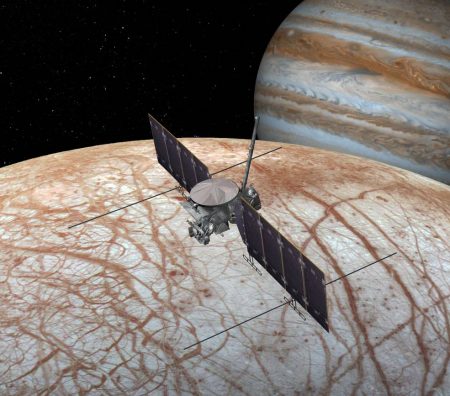May 14, 2018 – NASA today held a public information session about Europa, one of Jupiter’s larger moons. The crust of Europa is made of thin ice. Underneath that ice is a suspected ocean of water. Evidence of cryovolcanism on Europa’s surface has been detected by the Hubble Space Telescope. Cryovolcanoes don’t spout lava. They spout water.
When the Galileo mission first started circling Jupiter in 1995. It made eleven close flybys of Europa and magnetometer readings from one of those a mere 150 kilometers from the moon indicated something was erupting from the surface. This flyby approximated the location where Hubble first detected cryovolcanism. And coincidentally, the area where the plume was detected showed a thermal anomaly which indicates that what is emanating from the surface is warmer than what is found on its surface. The height of that plume is estimated to have reached 160 kilometers above the surface.
The implications of the existence of water beneath Europa’s crust that is warmer indicates that the moon has conditions that might be amicable to life.
Europa is considered to be a high-probability site for exobiology. That’s because liquid water is very close to the moon’s surface.
What causes Europa’s plumes?
The interaction of Jupiter and the neighbouring Jovian moon Io produces an incredible amount of energy in the form of tidal forces on Europa. And it is these tidal forces that planetary scientists believe is causing shifting in the icy surface and allowing for cryovolcanic eruptions.
What we still don’t know is the nature of Europa’s core. Is it solid or is the entire moon water? If solid, could the warming be caused by a hot core that features marine volcanoes erupting into the global ocean, transferring heat which is then leading to cryovolcanic activity at the surface?
Or are the plumes erupting from local warm spots, pockets of water in the crust that eventually reach the surface and escape into space?
NASA has planned a mission to Europa known as the Europa Clipper. It is planned for between 2022 and 2025. The Clipper will visit Europa at least 44 times in its mission and descend to heights above the surface as low as 25 kilometers. It is likely that cryovolcanic plumes will intersect with Clipper as it flies by.
Clipper will map the subsurface ocean. In addition, the instrumentation will be able to detect chemistry and constituent matter on the surface and within Europa’s plumes. Indirectly this may be able to tell us that microbial life exists on Europa.
















